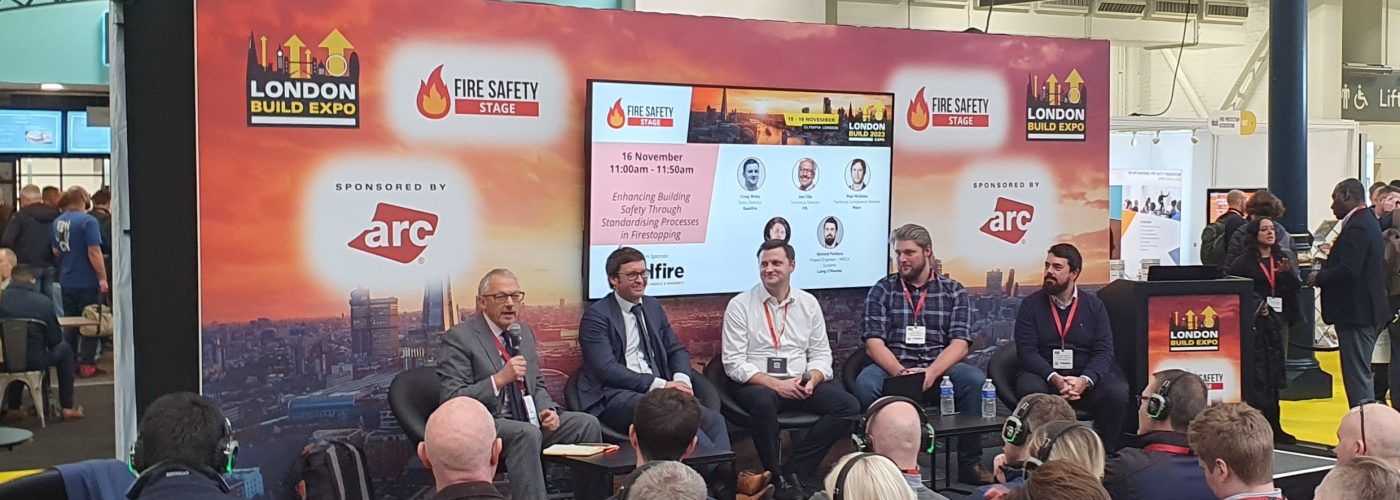The Passive Fire Knowledge Group aims to investigate, understand, inform, and promote knowledge and research in all areas of passive fire protection.
The tragedy of the Grenfell Tower has induced many positive changes in the industry, including more emphasis on service penetration sealing and early engagement. The traditional approach to service penetration sealing was to construct a building, create the apertures, and run all the services through before initiating contact with the firestopping contractor. However, as Craig Wells highlighted, the industry must approach construction from a ‘design, then build’ method – not the other way around.
Dame Judith Hackitt, author of the Independent Review of Building Regulations and Fire Safety, stated: “The industry must prepare and should be taking action ahead of legislation coming into force.” Service penetration seals involve the direct participation of many trades, requiring early engagement, attention to detail, and collaboration. For these concepts to be successful, an element of cultural change is needed.
Does this start with the vocabulary the industry uses?
The industry has long used the terms ‘passive fire protection’ and ‘firestopping’. While not inaccurate, these terms may be considered too generic, potentially misleading individuals unfamiliar with fire safety.
In recent years, there has been an effort to introduce the term ‘service penetration sealing’ as a more descriptive alternative. This term conveys the action of preserving the fire ratings of walls and floors by appropriately sealing service penetrations in a given application.
Also finding that vocabulary is often misused in the industry, Joe Cilia noted that terms like soundproof and fireproof do not exist. He also emphasised the prevailing attitude of the industry around stating that ‘it is just a wall’. Cilia said, “It is not just a wall. We have fire doors, fire glass, and fire doors – so why not fire walls?”
He said, “They are the largest passive fire product by area, yet we don’t describe them as such; if we did, we would be more likely to consider the detail and interface with the structure and elements such as MEP, leading to a safety-first approach.”
Further to this, Paul McSoley emphasised the importance of accuracy in service penetration sealing, noting that achieving success in this area begins with getting the language right first.
Firestopping of Service Penetrations: Best Practices in Design and Installation
In the guide jointly published by several industry associations titled Firestopping of Service Penetrations: Best Practices in Design and Installation, there are nine Golden Rules, seven of which relate to the building’s design.
This emphasises the importance of all parties, from architects to specialist firestopping contractors, engaging from the early stages of design to installation.
Nick Pickles highlighted the need for a mindset shift regarding design and build contracts. He pointed out that contractors often outline the project’s design only for it to be deviated from later down the line.
Adding to this point, Wells highlighted the importance of understanding the ‘what’ and the ‘why’ for all parties involved. He expressed the need to increase education and awareness in the industry while acknowledging greater collaboration.
Golden Rules One & Four
The Golden Rules have proved to be an invaluable resource across the industry post-Grenfell. The panellists referenced Golden Rule One and Golden Rule Four.
Golden Rule One relates to issuing early engagement with service penetration seal manufacturers and specialist installers. Golden Rule Four is about following the design process for penetration seals.
Wells stated that early engagement needs to be implemented because products must be installed as per the tested scope of application. First and foremost, to save lives, but also to avoid extra costs and delays and improve reputations. Aspects like the positioning of services, types of services and insulations, and sizing of letterboxes affect the products and system’s efficiency.
Today, firestopping solutions are typically selected by the main contractor. Because of this, they have the responsibility to ensure the chosen solutions are compliant and installed accordingly. As many external trades need to be involved, making it a complex process, implementing a standardised design process for each project is highly recommended.
Laing O’Rourke has defined a robust process from design through to handover, which clearly explains to designers how to position and size apertures, Richard Fordyce stated. He highlighted that this gives them the option to choose from multiple tested details as there will be enough space to accommodate services. Additionally, because of a robust design, the application becomes more straightforward, the installation is compliant, and an easy-to-follow document is issued upon handover.
McSoley added that project planning is a complicated process; he said, “You may select a lovely system of seals only to find out that the product is in the wrong location.” Thus, early engagement and standardising processes are crucial to solving any grey areas before the build commences.
Professor Stuart Green’s research into procurement practices found that 17% of rework on drylining could be avoided, but this could be applied across all areas. Cilia further highlighted that “we’re paying up to 17% more than we need to, at the back end of the job, because it is not being designed and scheduled properly in the first place.” He emphasised that the money wasted at the end of a project could be used at the forefront of the project instead, ensuring the layouts are agreed to in as much detail as possible. Extra costs and delays on remedial work can be avoided by involving the specialist drylining and firestopping contractor, as well as the manufacturers in the early stages of the project.
Meanwhile, Fordyce stressed that having a plan is essential. When the plan contributes to improved outcomes in terms of penetration sealing, there is no alternative approach. This provides better metrics and established rules and frameworks, as well as facilitates continuous improvement in construction practices each year. Consequently, this requires internal collaboration within the industry to establish compliant processes and external collaboration to ensure the golden thread is easily traceable and followed.
The construction industry and competency
Competency can be hard to measure, assess, or evaluate due to no benchmark to compare it to. Nevertheless, the panel agreed that competency can be observed through skills, knowledge, experience, and behaviour.
McSoley highlighted that there is vast information on pipes, trays, ducts, and dampers. The Best Practice Guide alone has 72 pages, illustrating the knowledge required to ensure these products are installed correctly. He pointed out that architects are expected to take on this level of work but can only do so if other parties share the correct information.
Fordyce said that competency is an emerging topic, and predicted the industry will begin to recognise it as a distinct construction discipline, similar to architecture and structural engineering, for example. He highlighted that the challenge with competency is that there is no base level of education; the industry is developing a new discipline but has to navigate it as it goes. Therefore, establishing it as a discipline will require an industry-wide collaboration.
To conclude, Pickles stated a significant gap exists in education and training. He highlighted the leap from IFE level 3 to degree and master’s programmes, emphasising the need to find ways to upskill and educate individuals involved in construction. Pickles said: “We’re not talking about a leaky pipe; we’re talking about life safety.”
The panel members were:
- Richard Fordyce, Specialist Project Engineer, Laing O’Rourke (Passive Fire Knowledge Group)
- Nick Pickles, Process and Assurance Lead, Laing O’Rourke
- Paul McSoley, Technical Compliance Director, Mace Group (Passive Fire Knowledge Group)
- Joe Cilia, Technical Director, Finishes & Interiors Sector (Passive Fire Knowledge Group)
- Moderator: Craig Wells, Sales Director, Quelfire
Building, Design & Construction Magazine | The Choice of Industry Professionals






